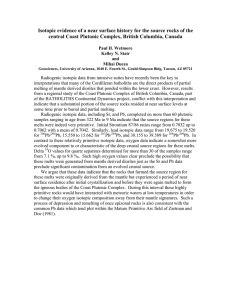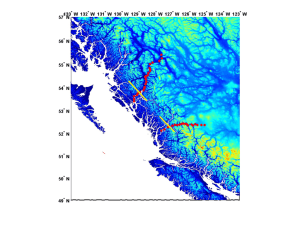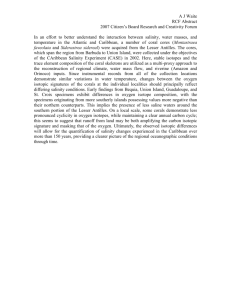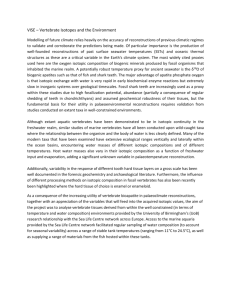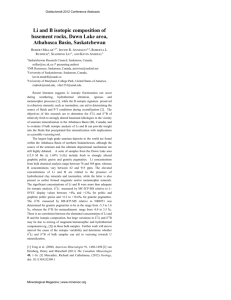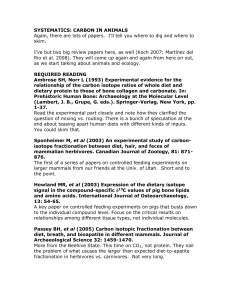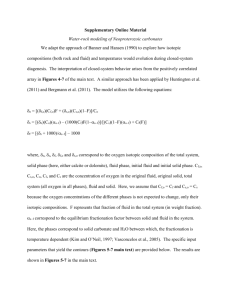USF
advertisement
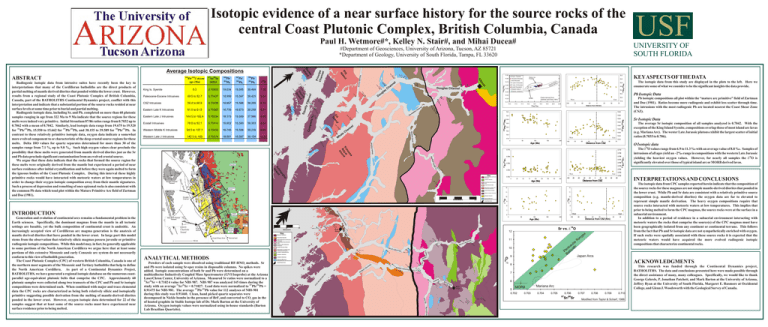
Isotopic evidence of a near surface history for the source rocks of the central Coast Plutonic Complex, British Columbia, Canada Paul H. Wetmore#*, Kelley N. Stair#, and Mihai Ducea# UNIVERSITY OF SOUTH FLORIDA #Department of Geosciences, University of Arizona, Tucson, AZ 85721 *Department of Geology, University of South Florida, Tampa, FL 33620 Western Early K 18.4 Western Jurassics GJP Pb 204 Pb isotopic compositions all plot within the “mature arc primitive” field of Zartman and Doe (1981). Ratios become more radiogenic and exhibit less scatter through time. The intrusions with the most radiogenic Pb are located nearest the Coast Shear Zone (CSZ). 17.8 17.0 17.5 18.0 18.5 206 Pb/204 Pb i 206 East 19.0 19.5 20.0 -100 20.5 -75 -50 -25 0 25 50 75 Distance from CSZ (km) Pb/ 204Pb 19.2 15.68 19.0 15.66 15.64 18.8 15.62 18.6 15.60 18.4 15.58 18.2 15.56 18.0 1 -8 15.54 West 17.8 East 100 150 200 -100 -75 -50 -25 0 25 50 75 Distance from CSZ O Isotopic data 80 PGJ 0.710 0.709 0.706 0.706 0.705 9 -7 7 PGJ GJP a 5 9. 7 M 87 5 1. l ana + Sr/ 86 Sr i 0.707 8 l ba West 0.703 East 0.702 0.702 0 25 50 75 100 125 150 175 -100 200 -80 -60 -40 7 -7 Ma GJP 0.7 + .6 Coast Shear Zone Intrusive Suite -20 0 20 40 60 INTERPRETATIONS AND CONCLUSIONS 80 Distance from CSZ Age (Ma) 55 Douglas Channel Transect Ecstall Intrusive Suite latest Early to earliest Late Cretaceous Intrusives 12 12 11 11 10 10 Kilometers 25 Paleozoic/Mesozoic Metasediments and Volcanics Coast Shear Zone T OR AF SE 7 7 6 6 -100 West 0 50 100 G 100.0 + 2.3 JP -4 0 Key Bella Bella -60 -40 -20 0 20 40 Distance from CSZ (Km) 18 G JP G JP 36 -3 5 G G JPJP 3 -3 3 4 Sr vs. d O 12 G JP -2 3 82.8 + 2.8 latest Paleocene and Eocene intrusives. Coast Shear Zone Intrusive Suite Eastern Late Cretaceous intrusives. 182.4 + 4.7 61.5 + 1.7 G JP -2 Ecstall Intrusive Suite DEA G JP -3 G JP -3 1 N CH AN N G JP G -2 JP 8 -2 78.8 + 1.8 9 EL 0 G JP -2 1 G D G JPG JP- 25 JP 2 -2 6 7 2 C EAN HA 11 EL NN 157.1 + 3.2 10 L 18 G JP -1 9 G JP -2 BURK E 9.3 + 0.4 G JP - CHAN 17 G JP -1 4 0 NEL G 52.7 + 1.5 JP -1 6 G JP -1 ACKNOWLEDGMENTS 8 This research was funded through the Continental Dynamics project, BATHOLITHS. The data and conclusions presented here were made possible through the direct assistance of many, many colleagues. Specifically, we would like to thank George Gehrels, P. Jonathan Patchett, and Mark Barton at the University of Arizona, Jeffrey Ryan at the University of South Florida, Margaret E. Rusmore at Occidental College, and Glenn J. Woodsworth with the Geological Survey of Canada. 5 G JP GJ -1 P98.4 + 1.8 3 12 7 58.4 + 1.9 SO UN H UG H FI TZ G JP -1 1 H RT 77.3 + 1.7 O N BE G N G JP -1 JP -0 9 0 TIN G JP CK -0 8 G JP -0 7 6 MORB Bella Coola 5 0.702 0.703 Mariana Arc 0.704 0.705 0.706 87 H SOUT G JP -0 3 G G JPJ G P- 0 4 JP 0 -0 5 6 144.5 + 2.9 GJ P0 1 The isotopic data from CPC samples reported herein indicate that the composition of the source rocks for these magmas are not simple mantle-derived diorites that ponded in the lower crust. While Pb and Sr data are consistent with a relatively primitive source composition (e.g. mantle-derived diorites) the oxygen data are far to elevated to represent simple mantle derivation. The heavy oxygen compositions require that source rocks interacted with meteoric waters at low temperatures. This implies that prior to being melted to form the CPC magmas, the source rocks were at the surface in a subaerial environment. In addition to a period of residence in a subaerial environment interacting with meteoric waters the rocks that comprise the source(s) of the CPC magmas must have been geographically isolated from any continent or continental terrane. This follows from the fact that Pb and Sr isotopic data are not sympathetically enriched with oxygen. If such rocks were spatially associated with these source rocks it is expected that the meteoric waters would have acquired the more evolved radiogenic isotopic compositions that characterize continental rocks. Japan Arcs D BU E K R A H C E NN G JP - Ch. Coast Shear Zone. 9 n a R s e g 18 Paleozoic/Mesozoic Metasediments and Volcanics. d O E ER CH Jurassic Intrusives. r a l u ns lith i n o e P ath B G JP -2 4 U LABO G 92.1 + 2.1 JP -3 2 Jurassic volcanics. -80 Age (Ma) King Island Syenite. latest Early to earliest Late Cretaceous Intrusives Jurassic metasediments. 200 L 20 G107.5 + 1.5 G JPJP 3 -3 7 8 150 East NE 10 Kilometers 107.6 + 3.0 G JP -3 9 Miocene volcanics. BENTINCK Powders of each sample were dissolved using traditional HF-HNO3 methods. Sr and Pb were isolated using Sr-spec resins in disposable columns. No spikes were added. Isotopic concentrations of both Sr and Pb were determined on a multicollector Inductively Coupled Mass Spectrometer (GVI Isoprobe) at the Arizona LaserChron Center, University of Ariznoa. Measured Sr ratios were normalized to a 87 Sr/86Sr = 0.7102 4 value for NBS 987. NBS 987 was analyzed 145 times during the 87 86 207 206 study with an average Sr/ Sr = 0.71027. Lead data were normalized to Pb/ Pb = 207 206 0.91475 for NBS 981. The average Pb/ Pb value for 112 analyses of NBS 981 during this study was 0.91460. Clean, hand picked quartz separates were decomposed in Nickle bombs in the presence of BrF5 and converted to CO2 gas in the of heated graphite in Stable Isotope lab of Dr. Mark Barton at the University of Arizona. Oxygen isotopic values were normalized using in-house standards (Barton Lab Brazilian Quartzite). 8 9 AN CH 0 ANALYTICAL METHODS 8 H Dean-Burk Channel Transect 9 d 18 O Paleozoic Intrusive d 18 O Central Gneiss Complex Western Jurassic Intrusives The d O values range from 6.9 to 11.3 %0 with an average value of 8.8 %0. Samples of intrusions of all ages yield an ~2%0 range in compositions with the western Late Jurassic 18 yielding the heaviest oxygen values. However, for nearly all samples the d O is significantly elevated over those of typical island arc or MORB derived lavas. 0.704 0.704 latest Paleocene and Eocene intrusives. S r/ 8 6 S r I 0.708 0.708 rC dne Gar ss ce in l Pr ya Ro land Is a M 60 .7 P- + 1 GJ 8.4 14 nal 50 0.710 Jurassic volcanics. INTRODUCTION The average Sr isotopic composition of all samples analyzed is 0.7042. With the exception of the King Island Syenite, compositions overlap those of most island arc lavas (e.g. Mariana Arc). The wester Late Jurassic plutons exhibit the largest scatter of initial ratios (0.7035 to 0.706). 18 Key N Sr Isotopic Data 15.52 0 Age (Ma) nel Ursula Chan 18.0 87 Prin Cha cipe nne l Is. pani a Pb Isotopic Data Pb/204 Pb 7 West The isotopic data from this study are displayed in the plots to the left. Here we enumerate some of what we consider to be the significant insights the data provide. 18.2 207 -8 Fields derived from Zartman and Doe (1981) MORB 15.10 16.5 GJP a Gardner C 1 le a h W l e n n a h C Pb/ 15.50 18.6 206 Pb/204Pb 207 1 -9 a GJP22M 3 88 PGJ nne l Ecstall Equivalent a M 6 Cam E Late Jr Intrusives 15.60 18.8 15.30 86 a P- .1 M GJ+ 1 .9 Cha at 0 -9 a GJP 52M d slan ks I c i c Ro ean Oc canic Vol E Late K Intrusives 15.40 81 7 84 0 . P- + GJ 60.9 -6 10.23 v as n tio a t el n an Ch KEY ASPECTS OF THE DATA 19.0 CSZ Intrusives 15.20 0 Generation and evolution of continental arcs remains a fundamental problem in the Earth sciences. Specifically, the dominant magmas from the mantle in all tectonic settings are basaltic, yet the bulk composition of continental crust is andesitic. An increasingly accepted view of Cordilleran arc magma generation is the anatexis of mantle derived diorites that have ponded in the lower crust. In large part this model stems from the observation that relatively silicic magmas possess juvenile or primitive radiogenic isotopic compositions. While this model may, in fact, be generally applicable to some portions of the North American Cordillera we argue here that at least some portions of this extensive Mesozoic and early Cenozoic arc system do not necessarily conform to this view of batholith generation. The Coast Plutonic Complex (CPC) of western British Columbia, Canada is one of the northern most segments of the Mesozoic and Tertiary batholiths that help to define the North American Cordillera. As part of a Continental Dynamics Project, BATHOLITHS, we have generated a regional isotopic database on the numerous coastparallel age-equivalent plutonic belts that comprise the CPC. Approximately 60 plutonic samples were collected along two transects of the CPC and Pb and Sr isotopic compositions were determined each. When combined with major and trace elemental data the CPC rocks are characterized as being both relatively silicic and isotopically primitive suggesting possible derivation from the melting of mantle-derived diorites ponded in the lower crust. However, oxygen isotopic data determined for 22 of the samples suggest that at least some of the source rocks must have experienced near surface residence prior to being melted. Mature Arc Primitive ~Eocene Intrusives 15.70 a M 7 a 0. + .8 M 1 .5 49 .8 + 82 1 P- 3 8 GJ JP-8 G Squ ally tim Ki 15.80 65 P- a GJ.4 M 1 + 38.154 9 0. 3 -6 15.567 62 a P- .1 M GJ + 1 .5 18.591 94 0.70474 -6 142.5 to 188 GJP Western Late J Intrusives De 10 GJP 8.65 64 P- Ma GJ1.7 + 7 7. 38.239 8.54 10 15.568 l Gi land Is 18.745 38.353 8.00 9 0.70434 15.593 37.966 5 PGJ 94.5 to 107.7 18.902 15.559 a M Western Middle K Intrusives 0.70414 18.375 8 -5 Ma GJP1.5 + 2 4. 78.8 to 92.1 0.70334 14 Ecstall Intrusives 144.5 to 182.4 GJP 4 Eastern Late J Intrusives 57 a P- 7 M GJ+ 1. 7 6. 9.31 55 .5 P- + 1 GJ7.8 14 38.259 6 -5 Ma GJP 1.9 + 5 2. 15.573 8.10 14 14 18.735 38.209 3 0.70363 15.588 5 PGJ 61.5 to 81.9 18.857 y ne wd De Is Eastern Late K Intrusives 0.70438 -5 58.4 to 60.9 GJP CSZ Intrusives D a M 8 9 1. P-8 GJ 9.54 Douglas Channel 5 -8 GJP a M 59 38.425 7 15.597 6 PGJ 18.959 2 0.70437 5 PGJ a 9M 49.5 to 52.7 + a M 1 1. + -68 .0 97 GJP 14 ch ut Tr land Is Paleocene-Eocene Intrusives as l g u o 2 0. 7.35 69 P- a GJ .2 M 1 + 38.468 .9 1 15.595 91 -5 19.034 7 2. Ma 15 1.9 + 0.70602 0 9.3 5 PGJ King Is. Syenite l e n n a h C 0 8. Ma 18 2.6 + -7 6 GJP O 19.2 King Is. Syenite 13 18 74 P- 5 GJ -7 GJP 73 PGJ 2 7 PGJ Pb/ 204 Pbi 1 -7 a M GJP0.9 + 208 70 P- Ma GJ110 94 Pb/ 204 Pbi .6 207 GJP Pb/ 204 Pbi 82 206 G r e n v i l le Chan ne l Sr/86Sr initial tt Pi land Is 87 15.90 za ta is Ar land Is Radiogenic isotopic data from intrusive suites have recently been the key to interpretations that many of the Cordilleran batholiths are the direct products of partial melting of mantle derived diorites that ponded within the lower crust. However, results from a regional study of the Coast Plutonic Complex of British Columbia, Canada, part of the BATHOLITHS Continental Dynamics project, conflict with this interpretation and indicate that a substantial portion of the source rocks resided at near surface levels at some time prior to burial and partial melting. Radiogenic isotopic data, including Sr, and Pb, completed on more than 60 plutonic samples ranging in age from 322 Ma to 9 Ma indicate that the source regions for these melts were indeed very primitive. Initial Strontium 87/86 ratios range from 0.7032 up to 0.7062 with a mean of 0.7042. Similarly, lead isotopic data range from 19.675 to 19.520 206 204 207 204 208 204 for Pb/ Pb, 15.550 to 15.662 for Pb/ Pb, and 38.155 to 39.589 for Pb/ Pb. In contrast to these relatively primitive isotopic data, oxygen data indicate a somewhat more evolved component to or characteristic of the deep crustal source regions for these melts. Delta 18O values for quartz separates determined for more than 30 of the samples range from 7.1 %0 up to 9.8 %0. Such high oxygen values clear preclude the possibility that these melts were generated from mantle derived diorites just as the Sr and Pb data preclude significant contamination from an evolved crustal source. We argue that these data indicate that the rocks that formed the source region for these melts were originally derived from the mantle but experienced a period of near surface residence after initial crystallization and before they were again melted to form the igneous bodies of the Coast Plutonic Complex. During this interval these highly primitive rocks would have interacted with meteoric waters at low temperatures in order to change their oxygen isotopic composition away from their mantle signatures. Such a process of depression and remelting of once epizonal rocks is also consistent with the common Pb data which tend plot within the Mature Primitive Arc field of Zartman and Doe (1981). Pb/238U zircon age (Ma) s nk Ba land Is ABSTRACT 206 N Average Isotopic Compositions USF 0.707 0.708 0.709 0.710 86 Sr/ Sr Modified from Taylor & Scharf, 1986
